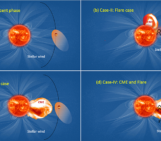
Geoscientists explore the nature from a different perspective than the commoners. In this week’s blog, Stephanie Sparks from Arizona State University shares her story how her passion for mountains gradually became her profession. Her journey through different regions in Himalaya leads her to understand the exhumation rate and the underlying geodynamic processes behind the formation of world’s highest mountain system.
Wandering in the mountains …

Stephanie Sparks from School of Earth and Space Exploration, Arizona State University.
In his National Book Award-winning story, The Snow Leopard, Peter Matthiessen writes of his time trekking through the landscapes of the Himalaya-Tibetan mountain system: “The secret of the mountains is that the mountains simply exist, as I do myself: the mountains exist simply, which I do not.”
Yet, I find something alluring about mountains that I’ve been drawn to as far back as my memories reach. My appreciation likely stemmed from being geographically situated within a short distance of the Appalachians during my formative years. I enjoyed time in my youth staring off into soft blue ridges coalescing on the horizon. As I got older, I enjoyed new-found freedoms of independent travel. I went westward, where the soft blue ridges materialized into rising rock monoliths that I hastily placed my feet upon. There began my everlasting bond to that mountainous landscape and the earth from which it formed.
While I continued to spend my free time in the great outdoors appreciating these phenomena, I did not immediately see in geology the potential for a life’s work. However, after my undergraduate, I was fortuitously encouraged to participate in a field study directed at introducing traditionally underrepresented groups to the geosciences. I was in disbelief when first experiencing the educational platforms afforded as a student of geology. The natural laboratories to which I was introduced were truly incredible. I was completely blown away: not only by the variability of features; but also, the new understanding of the processes that led to their formation.
Since that experience, I began to crave deeper perceptions of the natural environments which I had long enjoyed, and I was inspired by the realization of the interdisciplinary and international nature of geology. I therefore decided to tie together my interests and experiences by pursuing graduate research in continental tectonics. In this capacity, I now study the complex, interdependent processes that result in large-scale evolution of mountain ranges as well as travel into the field to experience the world’s most magnificent features.
Wondering about the mountains …

Author hiking up a waterfall along the Marsyangdi River, Nepal (Credit: Summer Brown)
For example, my research has taken me to the foothills and the high peaks of the Himalayan Mountain range, where I collected samples along river channels which naturally expose tectonostratigraphic units and bounding structures that run parallel to the Himalayan orogen. Transects collected across these units and structures can be analyzed using multi-system thermochronometry to calculate dates at which the rocks cooled below certain temperatures and these dates can in turn be used to constrain thermal-kinematic models that yield best-fit exhumation rates.
Understanding the rates at which collisional mountain systems like the Himalayas were exhumed is important in deciphering the nature of geodynamic processes that contributed to their formation. Geodynamic modeling of lithospheric deformation in a collisional system is useful in providing predictions for rates of orogenic processes that can in turn be validated by data derived from analytical studies as well as compared with results from complex thermal-kinetics models.
However, we are finding that the sensitivity of model outputs to even slight variations in parameters used as initial assumptions can be significant. Specifically, we employ a Taguchi design of experiments (Kacker et al., 1991) to evaluate the relative importance of 10% variations in input parameters (thermal, physical, and kinetic) on the results of a previously published, multichronometer Pecube-D model of exhumation rate variations over the past ca. 22 Ma. for a sample from the central Himalaya (Pye et al., 2022). Simultaneous variations of this magnitude in all input parameters result in ca. 5% average variations in calculated exhumation rates. The Taguchi experiments indicate that calculated exhumation rates are much more sensitive to uncertainties in some parameters than others; for example, a 10% uncertainty in the model basal temperature propagates into a 6.5% difference in exhumation rates. Such a fine-grained understanding of the main sources of uncertainties in these calculations helps the community establish realistic confidence levels for modeling results and identify how future efforts to refine our understanding of these parameters could improve exhumation history reconstructions. In turn, one method for testing the validity of predictions provided by geodynamic models can be improved.
References: Kacker, R. N., Lagergren, E. S., & Filliben, J. J. (1991). Taguchi's Orthogonal Arrays Are Classical Designs of Experiments. J Res Natl Inst Stand Technol, 96(5). Pye, A. E., Hodges, K. V., Keller, C. B., Law, R. D., van Soest, M. C., Bhandari, B., & McDonald, C. S. (2022). Prolonged slip on the South Tibetan detachment constrains tectonic models for synorogenic extension in the Central Himalaya. Tectonics, 41.





